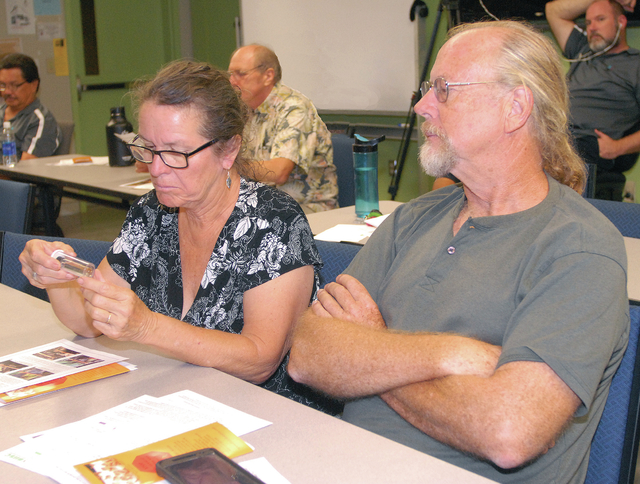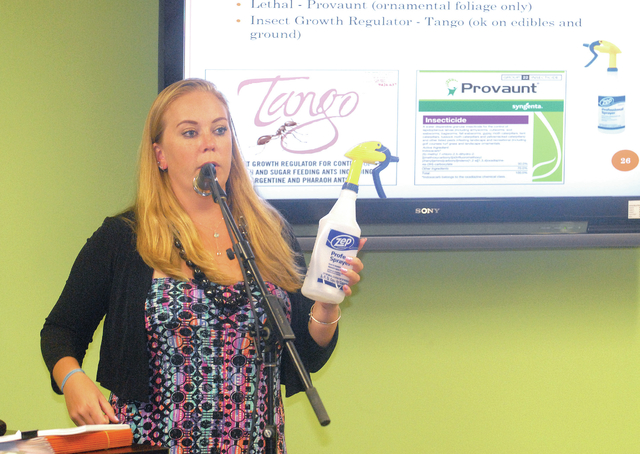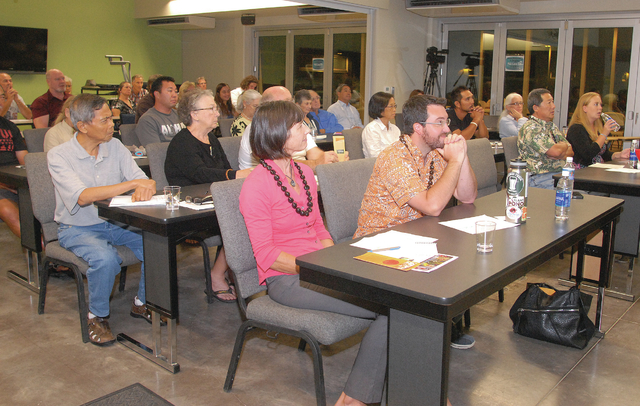KAILUA-KONA — You may be sitting on a little fire ant infestation and not even know it. ADVERTISING KAILUA-KONA — You may be sitting on a little fire ant infestation and not even know it. That little fire ants (LFA)
KAILUA-KONA — You may be sitting on a little fire ant infestation and not even know it.
That little fire ants (LFA) are a burgeoning problem in West Hawaii — and a bigger cause for concern than many people realize — was the premise for a recent forum held at Hawaii Community College, Palamanui.
Representatives from Hawaii County, the Department of Agriculture, the Hawaii Ant Lab and the Big Island Invasive Species Committee (BIISC) met with a couple dozen residents Thursday evening to disseminate information about surveying and combating the invasive pest.
LFA are known to dislike hot and dry climates, which may have provided some residents in West Hawaii with a false sense of security.
Heather Forester, invasive ant extension specialist with the Hawaii Ant Lab, said respect for the potential of current or future infestations is crucial to stopping the pest from becoming pervasive, as it already has in East Hawaii.
“When we start talking about those neighborhoods that have little fire ants, people say, ‘I’m not on that list. I’m not going to go home and check,’” Forester said.
She added the hardest part of her job is convincing people of the necessity of conducting a survey, because in reality, LFA could be anywhere. Forester mentioned reports of the pest at locations on Queen Kaahumanu Highway, Alii Drive and in Holualoa as well as Captain Cook.
Carolyn Dillon — an LFA community organizer in Holualoa, right in the heart of the largest known infestation in West Hawaii — said she first heard about the ants two years ago. But it was more than a year after that before she realized the scope of the problem and understood the ramifications of an LFA infestation.
LFA can live on the ground or in trees. On top of negatively impacting native bird and bee populations, the ants pack a painful sting that can contribute to blindness in household pets. Presenters at the forum estimated that LFA sting people and animals on Hawaii Island several million times annually.
These problems have presented clearly in Dillon’s neighborhood and surrounding communities. It’s likely they’re occurring in several other locations as well, or soon will be on a recognizable scale. Dillon said she’s spoken to landscapers who work up and down the Kona coast, some of whom say they’re bitten on a daily basis.
“The only reason we’re the largest known infestation is because we did huge testing,” Dillon said. “There are probably other communities sitting on fire ants, but neighbors haven’t gotten talking to each other, haven’t gotten organized and haven’t tested.”
The testing done in Holualoa was aided by the BIISC Little Fire Ant Community Support Program, which was followed by a treatment demonstration. Franny Brewer, BIISC’s communication director, said that same opportunity exists for anyone interested in surveying their neighborhood.
“We will come out to you and go through this whole process of mixing up this bait with you,” Brewer told the audience. “We will meet with your neighbors and explain everything.”
A collaborative community is necessary to effectively combat LFA, Brewer explained. Some of the most detrimental barriers are neighbors who aren’t concerned enough to engage with the process, allowing LFA populations to revitalize and create a never-ending infestation.
Collaboration is also valuable in the form of substantially reduced treatment costs for bait and barrier treatments, which can be learned about in more detail by contacting the Hawaii Ant Lab. A county voucher program is available to help offset some treatment costs, as well.
Brewer recommended the consistent administration of treatments over at least a 12-month period, as control measures may appear more effective in the immediate than they actually are.
The lab will also test deceased ant specimens, which can be delivered by car or mail, to verify if an ant problem is, in fact, LFA. The recommended method of collecting such specimens is to place chopsticks smeared with peanut butter in different locations around a property and see what comes.
Erin Lee, director of landscaping at the Four Seasons Resort Hualalai who attended the forum, said despite never having any real problems with the ants, her staff is constantly testing.
The diligent approach is one every presenter stressed Thursday night.
“It’s always a concern because we don’t want our guests and our employees being stung, and we have to keep it under control,” Lee said.








